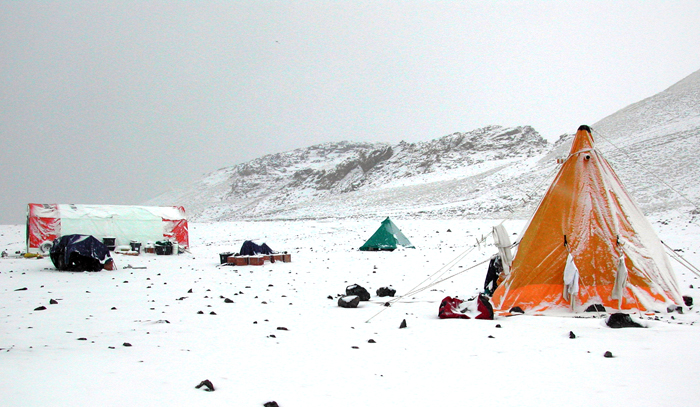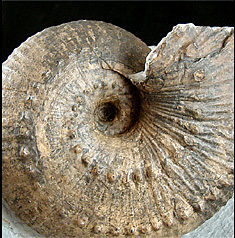Clues at high latitudesWard has devoted the last 15 years of his career to studying greenhouse extinctions. He recently published a book, “Under a Green Sky,” that details the competing hypotheses for these massive die offs. The Alvarez hypothesis held sway for many years, and Ward’s own work in the lower latitudes studying fossilized ammonites, shelled cephalopods that thrived prior to 65 million years ago, backed up the impact theory. To prove that K-T extinction was already under way before the Alvarez asteroid hit, the scientists need evidence that species diversity was already in decline. Such evidence of extinctions leading up to the K-T boundary may exist at the higher and colder latitudes, which are more sensitive to climate change, according to the scientists. More on Extinctions
Sun story: The Great Dying
Noted Tom Wagner, program manager of Earth Sciences at the National Science Foundation’s Office of Polar Programs “But its polar position is important, too. In this case, it will help characterize the extinction process,” he added. “Did extinction spread gradually across the globe? Were creatures in polar oceans affected differently than in the tropics? Are the poles a refuge or the first to go? Questions like this can only be answered by research in Antarctica.” “You really need to know what’s going on in the Southern Ocean to really understand what’s happening globally, to tie the rocks there with the rest of the world,” Kirschvink explained. And that’s the plan. The scientists will join colleagues from Argentina at James Ross and Seymour islands to collect samples for analysis in the lab. Kirschvink visited Seymour last year on something of a reconnaissance mission at the invitation of Eduardo Olivero, a paleontologist with the Argentine Antarctic program “Seymour Island section [of exposed rock] has the best time resolution I’ve ever seen for this K-T extinction boundary,” Kirschvink said. One meter represents about 4,000 years in geologic time. “It gives us the most incredible ability to go in and get high-resolution data with what was going on with this extinction than anywhere else I’ve seen,” he explained. “Not only that, the rocks are completely unheated, almost unburied, almost no alteration. … It’s an incredibly exciting sequence to work through. And fossils? You just whack on a few of these things, and boom, out come ammonites.” The scientists, along with graduate students from both countries, will spend about a month from mid-February to March digging out those fossils for analysis in this first field season. “We’re going to do some of the most horribly boring work on the face of the continent, any continent,” Ward said. Using a diamond-tipped coring drill, driven by a modified chainsaw, the scientists will extract small cores of rock, about 10 centimeters deep and about three centimeters in diameter, Ward explained. They will measure the spatial orientation of the cores with sun and magnetic compasses, and a bubble level, for the paleogmagnetic work. They will also record the cores’ position in the rock sequence relative to the mass extinction layer to understand the stratigraphy. Back at the lab, the scientists will measure the direction of its ancient magnetism, which can tell them what position the continent was in 65 million years ago. “More importantly, the Earth’s magnetic field reverses back and forth in a random pattern, and, as the history of these ‘geomagnetic reversals’ is well known during this time interval, the pattern of magnetic reversals can provide accurate age constraints on the sediments,” Kirschvink said. It will take at least a year before there are any results, Ward said. “The field work is the fun part and the lab work is slow.” Aside from Kirschvink’s trip to Seymour, both scientists are new to the U.S. Antarctic Program The project is not only about solving a murder mystery for Ward. He sees disturbing parallels between the past greenhouse extinctions and today’s climate change. Previous studies have suggested as much as 25 percent of the world’s species today may vanish before the end of the century unless greenhouse gases are curtailed. “I’m personally worried about sea level change,” Ward said. “Even a one-meter rise is going to be a disaster in the world. … It’s a good time for me to go back to the first [mass extinction] I ever studied after seeing what the greenhouse [extinctions] can do.” NSF-funded research in this story: Peter Ward and Eric Steig, University of Washington in Seattle, Award No. 0739432; and Joseph Kirschvink, California Institute of Technology, Award No. 0739541 |
"News about the USAP, the Ice, and the People"



For USAP Participants |
For The Public |
For Researchers and EducatorsContact UsU.S. National Science FoundationOffice of Polar Programs Geosciences Directorate 2415 Eisenhower Avenue, Suite W7100 Alexandria, VA 22314 Sign up for the NSF Office of Polar Programs newsletter and events. Feedback Form |



